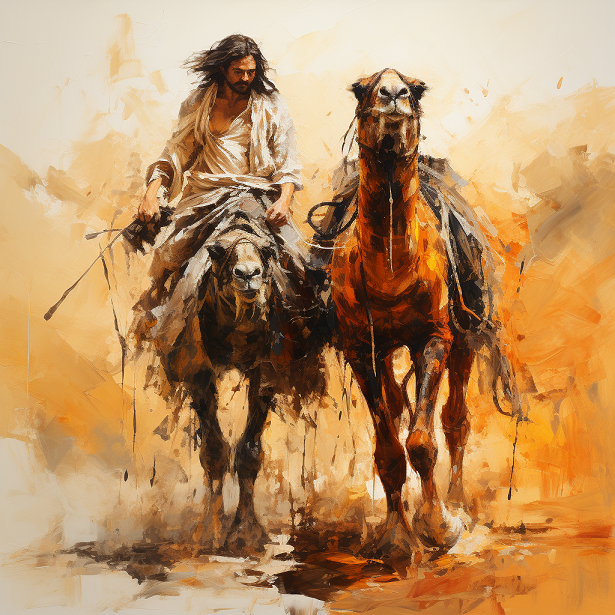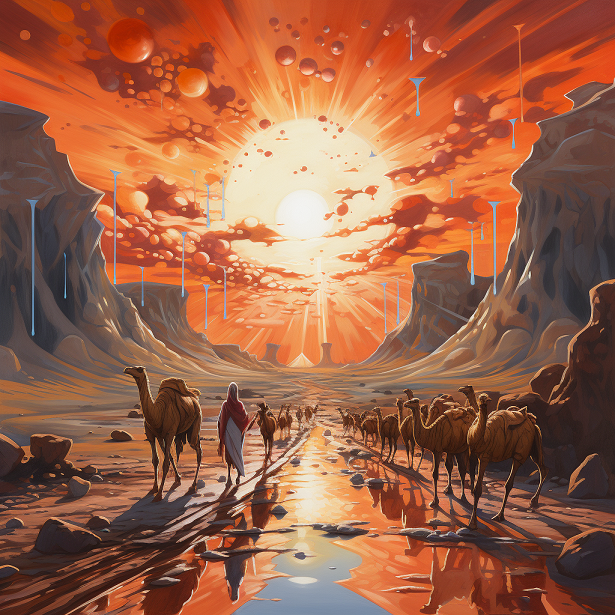John Keane (1854 – 1937) is one of the lesser-celebrated but highly remarkable figures in the history of Arabian travel writing. Born an Englishman in the 19th century, he embarked on a remarkable journey that transcended the conventional boundaries of historical exploration. Disguised as a Muslim, Keane immersed himself in the vibrant tapestry of Meccan life, where he lived for several months, providing a unique perspective on the intricacies of a city revered by many. The narrative that follows unfolds against the backdrop of Keane’s extended residence in Mecca, where his insightful observations and commitment to living incognito set the stage for an extraordinary pilgrimage to Medina. As we delve into his departure from Mecca, Keane’s expository voice guides us through the challenges and preparations that characterised this unconventional expedition.
Departure from Mecca
The departure from Mecca marked a pivotal chapter in John Keane’s odyssey, a chapter laden with both chaos and purpose. The formation of the caravan, a cacophony of activity, painted a vivid picture of the logistical intricacies involved in embarking on a pilgrimage. Keane introduces Amer, a wealthy Indian merchant under whose employment Keane found himself. Amidst the hustle, the meticulous organisation of supplies underscored the strategic planning required for such an unconventional venture.
From our tent-entrance the scene on every side presented a massed inextricable chaos of tents, camels, and men.
John Keane: My Journey To Medina
At the outset Keane points out that unlike the pilgrimage to Mecca, visiting Medina is of a non-obligatory nature, farming this voluntary journey as a profound act of respect to the Prophet of Islam. Keane, navigating the Sultan’s Road, presented the chosen route as not merely a geographic passage but a nuanced exploration of historical and cultural significance. The anticipation of challenges, the distance to be covered, and the underlying logistical considerations formed the backdrop for this departure, offering a glimpse into the meticulous preparations that would shape the ensuing pilgrimage.
Camp Life and Observations
Within the sprawling camp near Mecca, Keane’s narrative transforms into a canvas depicting the rhythm of daily life and the unique dynamics that govern the pilgrimage preparations. Amidst the seeming chaos, a methodical organisation emerged as caravans, composed of individuals sharing a common language, coalesced to form units ready to embark on their journey.
The wells, scattered across the camp, became pivotal hubs of activity. Stone walls and troughs framed these water sources, witnessing the convergence of Bedouin nomads and pilgrims. Keane’s deep observations, often from elevated viewpoints, unveiled the intricacies of this transient society. His penchant for climbing hills, a recurring motif, offered both amusement and insight, revealing a commitment to thorough observation.
As the camp teemed with life, Keane introduces the reader to Amir’s distinguished strangers, adding complexity to the human tapestry of the pilgrimage. These moments of calm amid the bustling activity hint at the dual nature of the pilgrimage—a spiritual endeavour intertwined with the pragmatic realities of camp life.
Setting Out
The departure from the camp signalled a transition from the organised chaos of preparation to the tangible commencement of the pilgrimage. Keane, in his role as an observer and participant, provides a nuanced account of the rituals surrounding the setting out.
Preparations for departure included not only the physical disassembly of tents but also the symbolic act of gathering flowers. Presenting these flowers to the Amir, Keane bridged the cultural gaps, emphasising his deep immersion into the local customs.
The selection and inspection of the camel revealed unforeseen challenges and surprises, echoing the unpredictability that often accompanies such journeys. The anticipation and uncertainty of the road ahead became palpable as the caravan prepared to set out, leaving behind the familiar camp life and venturing into the vastness of the Sultan’s Road.
Mounting the Camel
Amidst the anticipation of the journey ahead, a pivotal moment unfolded as John Keane and his fellow pilgrims prepared to mount their camels. The process, described with a keen eye for detail, encapsulated the intricate dance between man and beast.
The camel mounting process, portrayed as a delicate art, required a blend of physical skill and understanding of the camel’s movements. Keane, providing a vivid description, detailed the manoeuvres involved in ascending onto the camel’s back without the aid of a ladder. The challenges faced during this process reflected the physical demands and adaptability required for travel in the arduous desert terrain.
We now had to mount our camel without a ladder. This is done by first pulling the animal’s head down to the ground with the left hand, and then quickly placing the left foot in the hollow of the back of its neck, at the same time catching at the rise of its shoulder with the right and letting go with the left hand, the animal then throws up its head, and with a slight turn of your body you find yourself placed deftly in the saddle.
John Keane : My Journey To Medina
The camels, connected by tow-ropes, were not mere modes of transportation but intricate elements of the pilgrimage. Keane’s depiction highlighted the characteristics of these desert dwellers and the practical details of their management, including the use of spurring-curbs for reluctant camels.
On the Camel
As the caravan set in motion, the experience of riding atop the camel brought forth both physical challenges and an array of sensory perceptions. John Keane, now an active participant in the pilgrimage, shared his reflections on the camel ride with a blend of pragmatism and introspection.
The camel ride, while a means of traversal, revealed the discomfort inherent in the journey. Keane’s portrayal spared no detail, presenting the reader with the physical toll exacted by the camel’s gait and the prolonged stretches in a constrained position within the shugduf. The journey, far from a romanticised adventure, unfolded as a test of endurance against the unforgiving elements of the desert.
Amidst the discomfort, Keane’s anticipation of challenges loomed large. Hunger gnawed at the pilgrims, and unpleasant smells added another layer to the physical strain. The narrative, devoid of embellishments, captured the raw essence of the pilgrimage, offering readers an unvarnished glimpse into the realities faced by those embarking on this transformative journey.

John Kean’s departure from Mecca, with its rich tapestry of observations, sets the stage for a journey that extends beyond geographical boundaries. Keane’s commitment to an unembellished narrative, rooted in his writing, ensures a genuine and informative exploration of this unique historical and cultural experience. As we venture further into the pilgrimage, the desert sands bear witness to a narrative that unfolds with the weight of authenticity and the richness of unfiltered observation.

